Change Management
VerifiedAdded on 2023/04/20
|9
|3005
|306
AI Summary
This article discusses the implementation of change management in Woolworths, one of the biggest supermarket chains in Australia. It explores the diagnosis models, such as the McKinsey 7s model and Kotter's integrative model, and the intervention strategies used by the organization. The article emphasizes the importance of adapting to the changing retail market and maintaining a competitive edge.
Contribute Materials
Your contribution can guide someone’s learning journey. Share your
documents today.
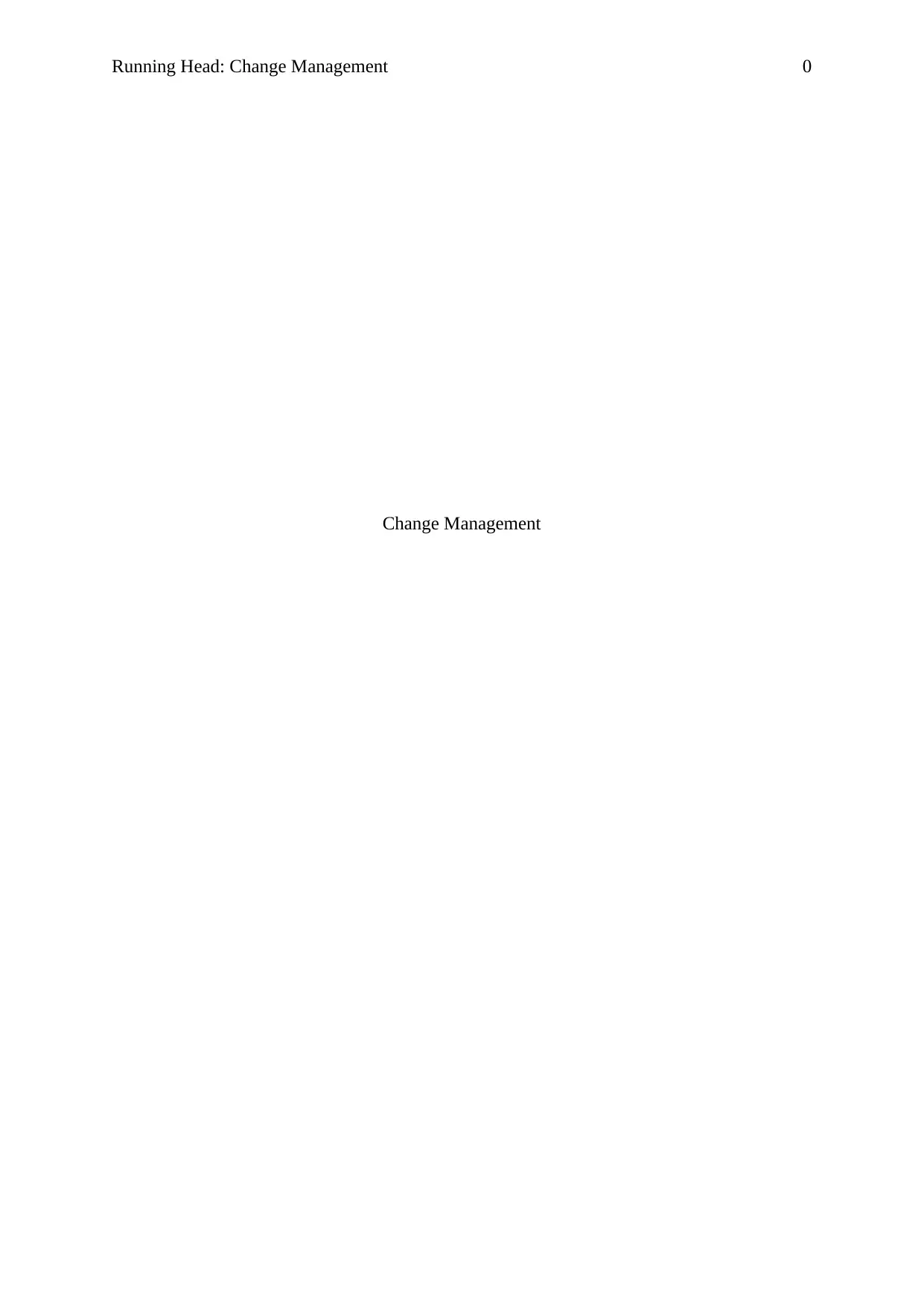
Running Head: Change Management 0
Change Management
Change Management
Secure Best Marks with AI Grader
Need help grading? Try our AI Grader for instant feedback on your assignments.
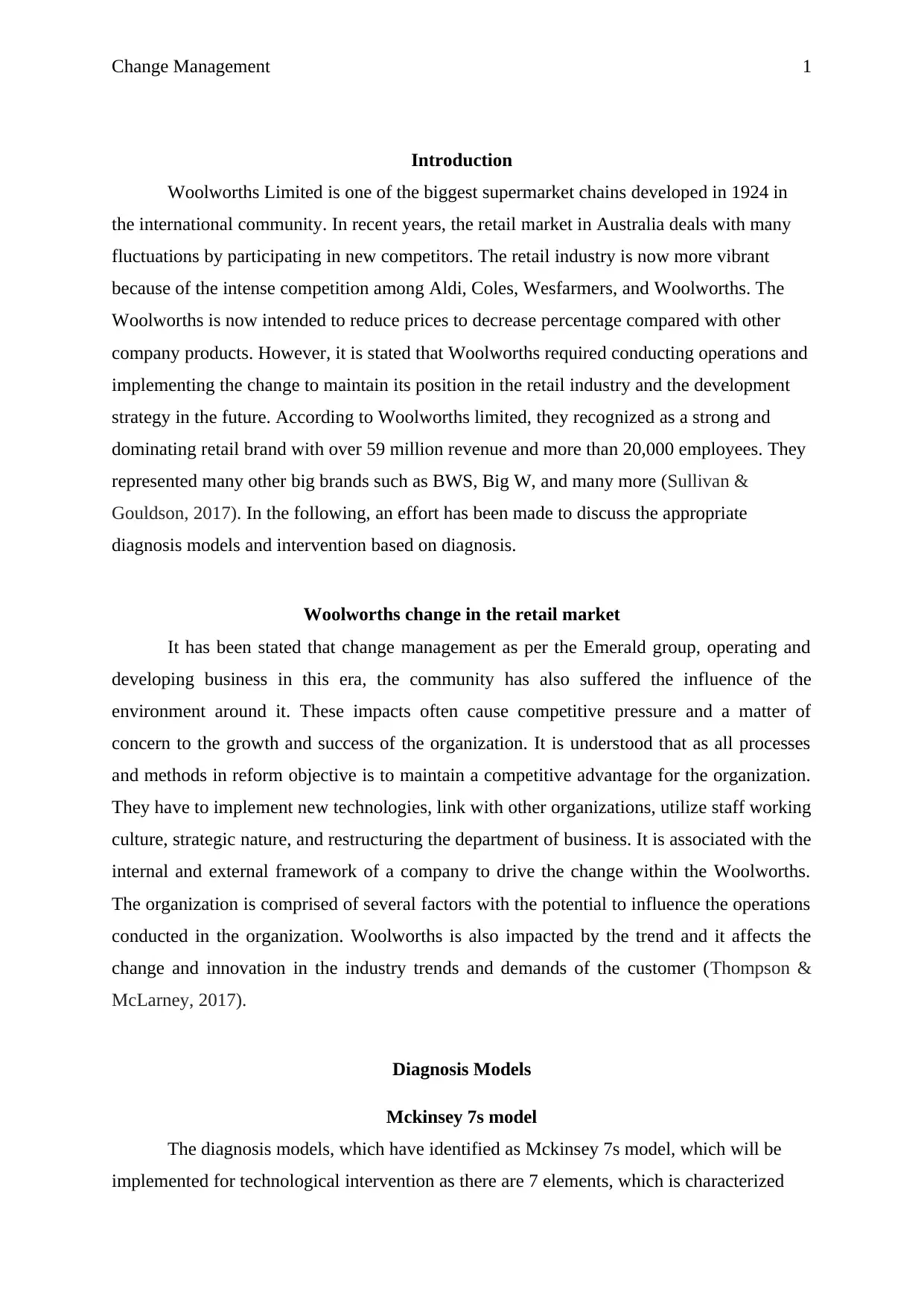
Change Management 1
Introduction
Woolworths Limited is one of the biggest supermarket chains developed in 1924 in
the international community. In recent years, the retail market in Australia deals with many
fluctuations by participating in new competitors. The retail industry is now more vibrant
because of the intense competition among Aldi, Coles, Wesfarmers, and Woolworths. The
Woolworths is now intended to reduce prices to decrease percentage compared with other
company products. However, it is stated that Woolworths required conducting operations and
implementing the change to maintain its position in the retail industry and the development
strategy in the future. According to Woolworths limited, they recognized as a strong and
dominating retail brand with over 59 million revenue and more than 20,000 employees. They
represented many other big brands such as BWS, Big W, and many more (Sullivan &
Gouldson, 2017). In the following, an effort has been made to discuss the appropriate
diagnosis models and intervention based on diagnosis.
Woolworths change in the retail market
It has been stated that change management as per the Emerald group, operating and
developing business in this era, the community has also suffered the influence of the
environment around it. These impacts often cause competitive pressure and a matter of
concern to the growth and success of the organization. It is understood that as all processes
and methods in reform objective is to maintain a competitive advantage for the organization.
They have to implement new technologies, link with other organizations, utilize staff working
culture, strategic nature, and restructuring the department of business. It is associated with the
internal and external framework of a company to drive the change within the Woolworths.
The organization is comprised of several factors with the potential to influence the operations
conducted in the organization. Woolworths is also impacted by the trend and it affects the
change and innovation in the industry trends and demands of the customer (Thompson &
McLarney, 2017).
Diagnosis Models
Mckinsey 7s model
The diagnosis models, which have identified as Mckinsey 7s model, which will be
implemented for technological intervention as there are 7 elements, which is characterized
Introduction
Woolworths Limited is one of the biggest supermarket chains developed in 1924 in
the international community. In recent years, the retail market in Australia deals with many
fluctuations by participating in new competitors. The retail industry is now more vibrant
because of the intense competition among Aldi, Coles, Wesfarmers, and Woolworths. The
Woolworths is now intended to reduce prices to decrease percentage compared with other
company products. However, it is stated that Woolworths required conducting operations and
implementing the change to maintain its position in the retail industry and the development
strategy in the future. According to Woolworths limited, they recognized as a strong and
dominating retail brand with over 59 million revenue and more than 20,000 employees. They
represented many other big brands such as BWS, Big W, and many more (Sullivan &
Gouldson, 2017). In the following, an effort has been made to discuss the appropriate
diagnosis models and intervention based on diagnosis.
Woolworths change in the retail market
It has been stated that change management as per the Emerald group, operating and
developing business in this era, the community has also suffered the influence of the
environment around it. These impacts often cause competitive pressure and a matter of
concern to the growth and success of the organization. It is understood that as all processes
and methods in reform objective is to maintain a competitive advantage for the organization.
They have to implement new technologies, link with other organizations, utilize staff working
culture, strategic nature, and restructuring the department of business. It is associated with the
internal and external framework of a company to drive the change within the Woolworths.
The organization is comprised of several factors with the potential to influence the operations
conducted in the organization. Woolworths is also impacted by the trend and it affects the
change and innovation in the industry trends and demands of the customer (Thompson &
McLarney, 2017).
Diagnosis Models
Mckinsey 7s model
The diagnosis models, which have identified as Mckinsey 7s model, which will be
implemented for technological intervention as there are 7 elements, which is characterized
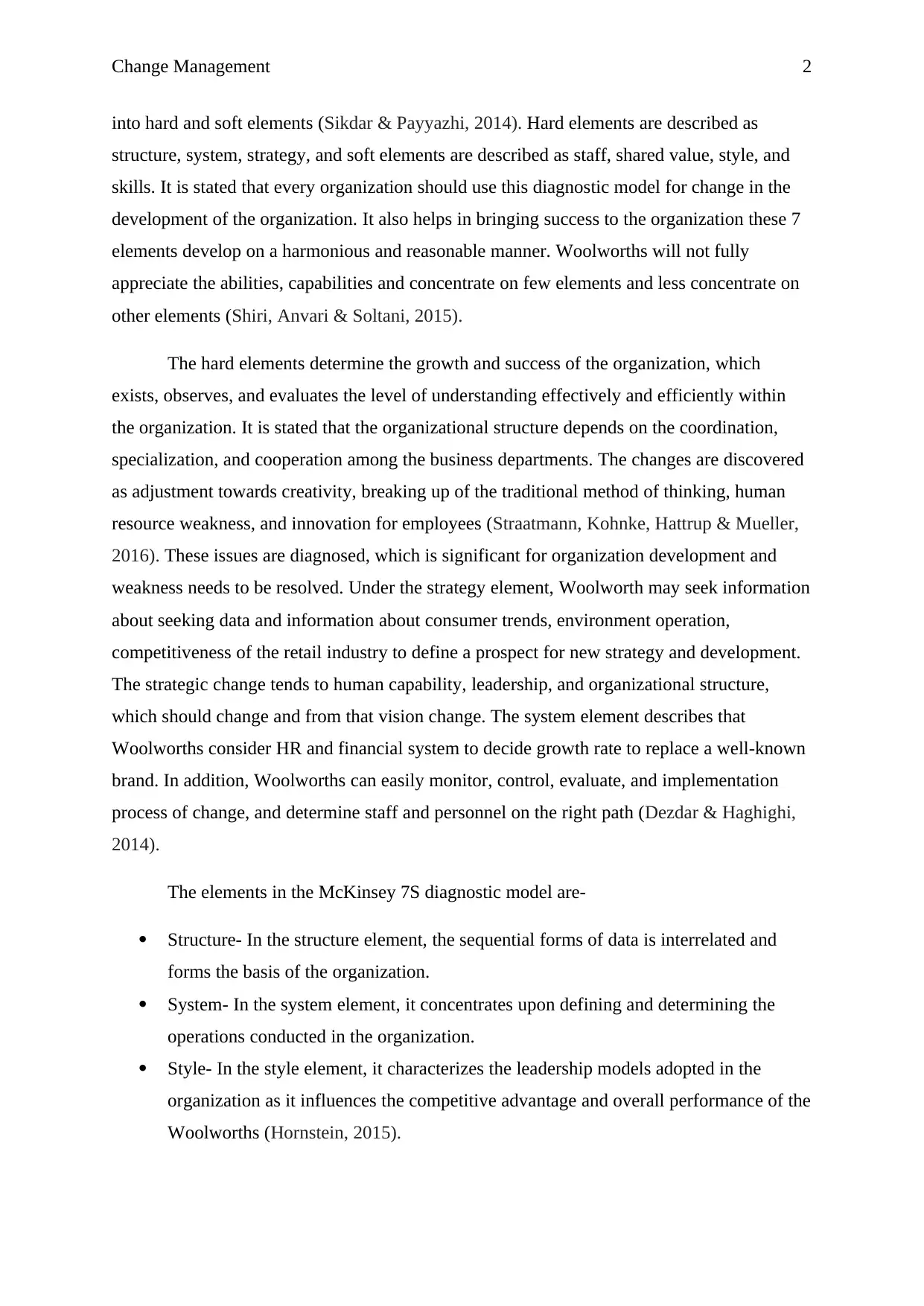
Change Management 2
into hard and soft elements (Sikdar & Payyazhi, 2014). Hard elements are described as
structure, system, strategy, and soft elements are described as staff, shared value, style, and
skills. It is stated that every organization should use this diagnostic model for change in the
development of the organization. It also helps in bringing success to the organization these 7
elements develop on a harmonious and reasonable manner. Woolworths will not fully
appreciate the abilities, capabilities and concentrate on few elements and less concentrate on
other elements (Shiri, Anvari & Soltani, 2015).
The hard elements determine the growth and success of the organization, which
exists, observes, and evaluates the level of understanding effectively and efficiently within
the organization. It is stated that the organizational structure depends on the coordination,
specialization, and cooperation among the business departments. The changes are discovered
as adjustment towards creativity, breaking up of the traditional method of thinking, human
resource weakness, and innovation for employees (Straatmann, Kohnke, Hattrup & Mueller,
2016). These issues are diagnosed, which is significant for organization development and
weakness needs to be resolved. Under the strategy element, Woolworth may seek information
about seeking data and information about consumer trends, environment operation,
competitiveness of the retail industry to define a prospect for new strategy and development.
The strategic change tends to human capability, leadership, and organizational structure,
which should change and from that vision change. The system element describes that
Woolworths consider HR and financial system to decide growth rate to replace a well-known
brand. In addition, Woolworths can easily monitor, control, evaluate, and implementation
process of change, and determine staff and personnel on the right path (Dezdar & Haghighi,
2014).
The elements in the McKinsey 7S diagnostic model are-
Structure- In the structure element, the sequential forms of data is interrelated and
forms the basis of the organization.
System- In the system element, it concentrates upon defining and determining the
operations conducted in the organization.
Style- In the style element, it characterizes the leadership models adopted in the
organization as it influences the competitive advantage and overall performance of the
Woolworths (Hornstein, 2015).
into hard and soft elements (Sikdar & Payyazhi, 2014). Hard elements are described as
structure, system, strategy, and soft elements are described as staff, shared value, style, and
skills. It is stated that every organization should use this diagnostic model for change in the
development of the organization. It also helps in bringing success to the organization these 7
elements develop on a harmonious and reasonable manner. Woolworths will not fully
appreciate the abilities, capabilities and concentrate on few elements and less concentrate on
other elements (Shiri, Anvari & Soltani, 2015).
The hard elements determine the growth and success of the organization, which
exists, observes, and evaluates the level of understanding effectively and efficiently within
the organization. It is stated that the organizational structure depends on the coordination,
specialization, and cooperation among the business departments. The changes are discovered
as adjustment towards creativity, breaking up of the traditional method of thinking, human
resource weakness, and innovation for employees (Straatmann, Kohnke, Hattrup & Mueller,
2016). These issues are diagnosed, which is significant for organization development and
weakness needs to be resolved. Under the strategy element, Woolworth may seek information
about seeking data and information about consumer trends, environment operation,
competitiveness of the retail industry to define a prospect for new strategy and development.
The strategic change tends to human capability, leadership, and organizational structure,
which should change and from that vision change. The system element describes that
Woolworths consider HR and financial system to decide growth rate to replace a well-known
brand. In addition, Woolworths can easily monitor, control, evaluate, and implementation
process of change, and determine staff and personnel on the right path (Dezdar & Haghighi,
2014).
The elements in the McKinsey 7S diagnostic model are-
Structure- In the structure element, the sequential forms of data is interrelated and
forms the basis of the organization.
System- In the system element, it concentrates upon defining and determining the
operations conducted in the organization.
Style- In the style element, it characterizes the leadership models adopted in the
organization as it influences the competitive advantage and overall performance of the
Woolworths (Hornstein, 2015).
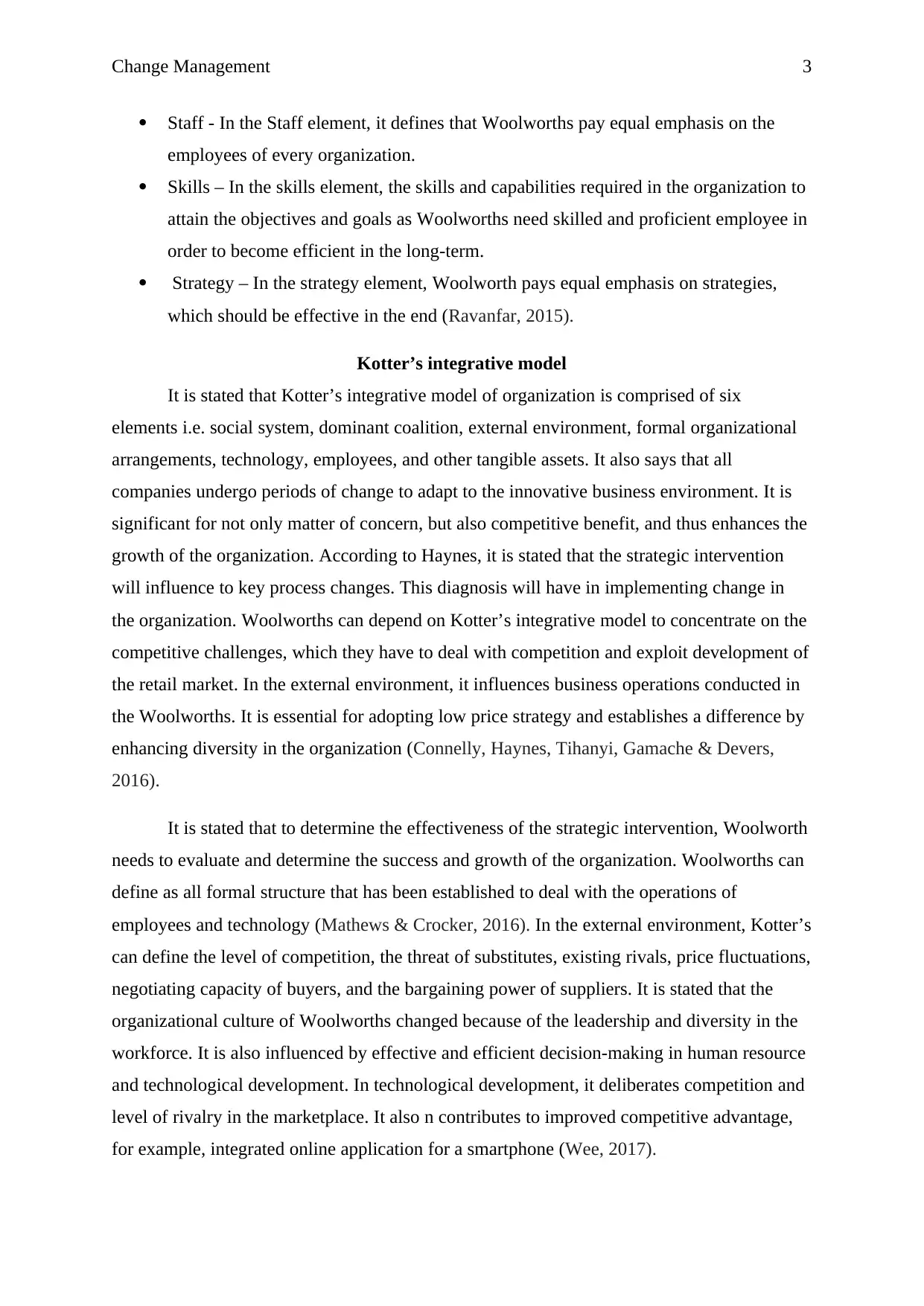
Change Management 3
Staff - In the Staff element, it defines that Woolworths pay equal emphasis on the
employees of every organization.
Skills – In the skills element, the skills and capabilities required in the organization to
attain the objectives and goals as Woolworths need skilled and proficient employee in
order to become efficient in the long-term.
Strategy – In the strategy element, Woolworth pays equal emphasis on strategies,
which should be effective in the end (Ravanfar, 2015).
Kotter’s integrative model
It is stated that Kotter’s integrative model of organization is comprised of six
elements i.e. social system, dominant coalition, external environment, formal organizational
arrangements, technology, employees, and other tangible assets. It also says that all
companies undergo periods of change to adapt to the innovative business environment. It is
significant for not only matter of concern, but also competitive benefit, and thus enhances the
growth of the organization. According to Haynes, it is stated that the strategic intervention
will influence to key process changes. This diagnosis will have in implementing change in
the organization. Woolworths can depend on Kotter’s integrative model to concentrate on the
competitive challenges, which they have to deal with competition and exploit development of
the retail market. In the external environment, it influences business operations conducted in
the Woolworths. It is essential for adopting low price strategy and establishes a difference by
enhancing diversity in the organization (Connelly, Haynes, Tihanyi, Gamache & Devers,
2016).
It is stated that to determine the effectiveness of the strategic intervention, Woolworth
needs to evaluate and determine the success and growth of the organization. Woolworths can
define as all formal structure that has been established to deal with the operations of
employees and technology (Mathews & Crocker, 2016). In the external environment, Kotter’s
can define the level of competition, the threat of substitutes, existing rivals, price fluctuations,
negotiating capacity of buyers, and the bargaining power of suppliers. It is stated that the
organizational culture of Woolworths changed because of the leadership and diversity in the
workforce. It is also influenced by effective and efficient decision-making in human resource
and technological development. In technological development, it deliberates competition and
level of rivalry in the marketplace. It also n contributes to improved competitive advantage,
for example, integrated online application for a smartphone (Wee, 2017).
Staff - In the Staff element, it defines that Woolworths pay equal emphasis on the
employees of every organization.
Skills – In the skills element, the skills and capabilities required in the organization to
attain the objectives and goals as Woolworths need skilled and proficient employee in
order to become efficient in the long-term.
Strategy – In the strategy element, Woolworth pays equal emphasis on strategies,
which should be effective in the end (Ravanfar, 2015).
Kotter’s integrative model
It is stated that Kotter’s integrative model of organization is comprised of six
elements i.e. social system, dominant coalition, external environment, formal organizational
arrangements, technology, employees, and other tangible assets. It also says that all
companies undergo periods of change to adapt to the innovative business environment. It is
significant for not only matter of concern, but also competitive benefit, and thus enhances the
growth of the organization. According to Haynes, it is stated that the strategic intervention
will influence to key process changes. This diagnosis will have in implementing change in
the organization. Woolworths can depend on Kotter’s integrative model to concentrate on the
competitive challenges, which they have to deal with competition and exploit development of
the retail market. In the external environment, it influences business operations conducted in
the Woolworths. It is essential for adopting low price strategy and establishes a difference by
enhancing diversity in the organization (Connelly, Haynes, Tihanyi, Gamache & Devers,
2016).
It is stated that to determine the effectiveness of the strategic intervention, Woolworth
needs to evaluate and determine the success and growth of the organization. Woolworths can
define as all formal structure that has been established to deal with the operations of
employees and technology (Mathews & Crocker, 2016). In the external environment, Kotter’s
can define the level of competition, the threat of substitutes, existing rivals, price fluctuations,
negotiating capacity of buyers, and the bargaining power of suppliers. It is stated that the
organizational culture of Woolworths changed because of the leadership and diversity in the
workforce. It is also influenced by effective and efficient decision-making in human resource
and technological development. In technological development, it deliberates competition and
level of rivalry in the marketplace. It also n contributes to improved competitive advantage,
for example, integrated online application for a smartphone (Wee, 2017).
Secure Best Marks with AI Grader
Need help grading? Try our AI Grader for instant feedback on your assignments.
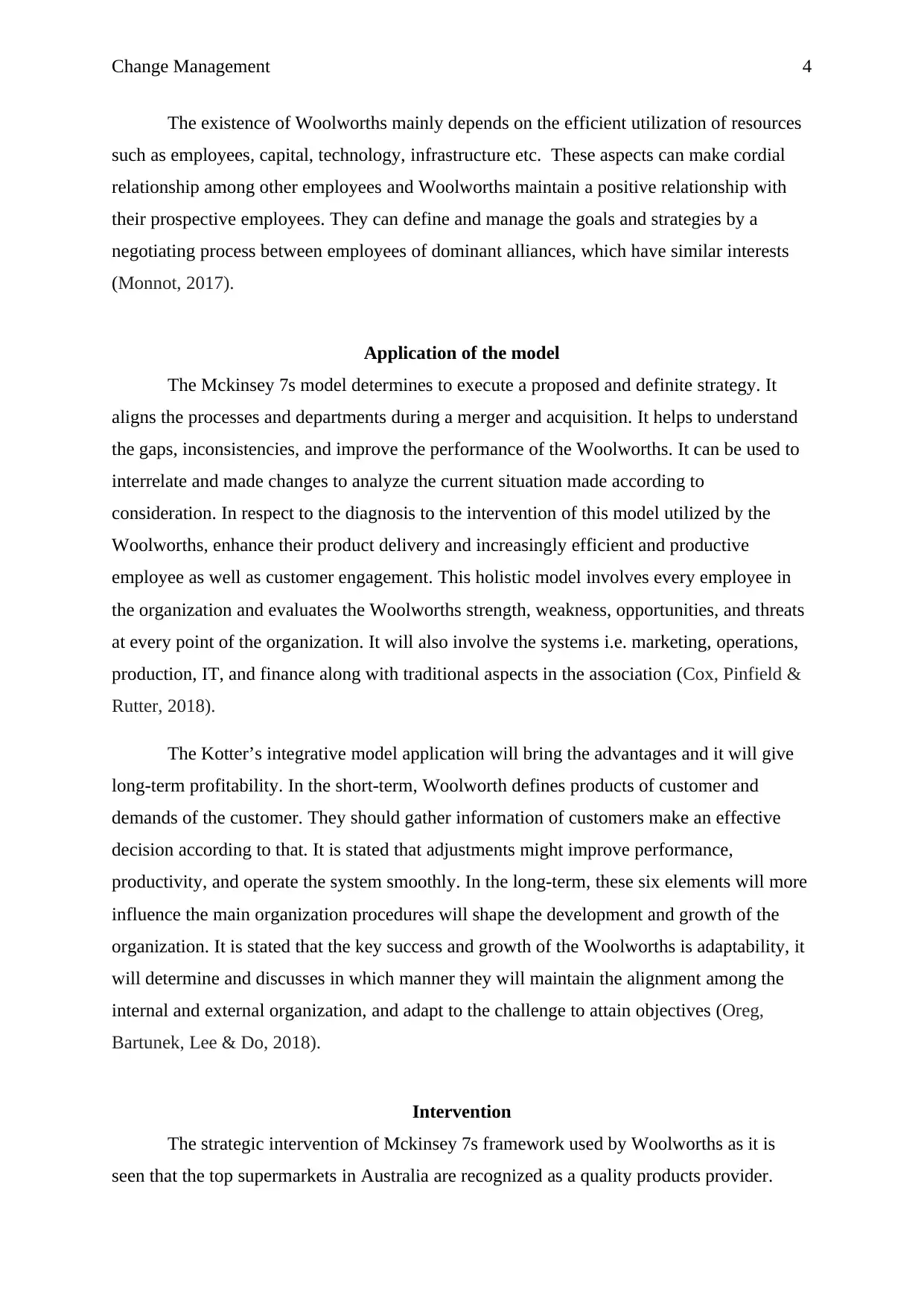
Change Management 4
The existence of Woolworths mainly depends on the efficient utilization of resources
such as employees, capital, technology, infrastructure etc. These aspects can make cordial
relationship among other employees and Woolworths maintain a positive relationship with
their prospective employees. They can define and manage the goals and strategies by a
negotiating process between employees of dominant alliances, which have similar interests
(Monnot, 2017).
Application of the model
The Mckinsey 7s model determines to execute a proposed and definite strategy. It
aligns the processes and departments during a merger and acquisition. It helps to understand
the gaps, inconsistencies, and improve the performance of the Woolworths. It can be used to
interrelate and made changes to analyze the current situation made according to
consideration. In respect to the diagnosis to the intervention of this model utilized by the
Woolworths, enhance their product delivery and increasingly efficient and productive
employee as well as customer engagement. This holistic model involves every employee in
the organization and evaluates the Woolworths strength, weakness, opportunities, and threats
at every point of the organization. It will also involve the systems i.e. marketing, operations,
production, IT, and finance along with traditional aspects in the association (Cox, Pinfield &
Rutter, 2018).
The Kotter’s integrative model application will bring the advantages and it will give
long-term profitability. In the short-term, Woolworth defines products of customer and
demands of the customer. They should gather information of customers make an effective
decision according to that. It is stated that adjustments might improve performance,
productivity, and operate the system smoothly. In the long-term, these six elements will more
influence the main organization procedures will shape the development and growth of the
organization. It is stated that the key success and growth of the Woolworths is adaptability, it
will determine and discusses in which manner they will maintain the alignment among the
internal and external organization, and adapt to the challenge to attain objectives (Oreg,
Bartunek, Lee & Do, 2018).
Intervention
The strategic intervention of Mckinsey 7s framework used by Woolworths as it is
seen that the top supermarkets in Australia are recognized as a quality products provider.
The existence of Woolworths mainly depends on the efficient utilization of resources
such as employees, capital, technology, infrastructure etc. These aspects can make cordial
relationship among other employees and Woolworths maintain a positive relationship with
their prospective employees. They can define and manage the goals and strategies by a
negotiating process between employees of dominant alliances, which have similar interests
(Monnot, 2017).
Application of the model
The Mckinsey 7s model determines to execute a proposed and definite strategy. It
aligns the processes and departments during a merger and acquisition. It helps to understand
the gaps, inconsistencies, and improve the performance of the Woolworths. It can be used to
interrelate and made changes to analyze the current situation made according to
consideration. In respect to the diagnosis to the intervention of this model utilized by the
Woolworths, enhance their product delivery and increasingly efficient and productive
employee as well as customer engagement. This holistic model involves every employee in
the organization and evaluates the Woolworths strength, weakness, opportunities, and threats
at every point of the organization. It will also involve the systems i.e. marketing, operations,
production, IT, and finance along with traditional aspects in the association (Cox, Pinfield &
Rutter, 2018).
The Kotter’s integrative model application will bring the advantages and it will give
long-term profitability. In the short-term, Woolworth defines products of customer and
demands of the customer. They should gather information of customers make an effective
decision according to that. It is stated that adjustments might improve performance,
productivity, and operate the system smoothly. In the long-term, these six elements will more
influence the main organization procedures will shape the development and growth of the
organization. It is stated that the key success and growth of the Woolworths is adaptability, it
will determine and discusses in which manner they will maintain the alignment among the
internal and external organization, and adapt to the challenge to attain objectives (Oreg,
Bartunek, Lee & Do, 2018).
Intervention
The strategic intervention of Mckinsey 7s framework used by Woolworths as it is
seen that the top supermarkets in Australia are recognized as a quality products provider.
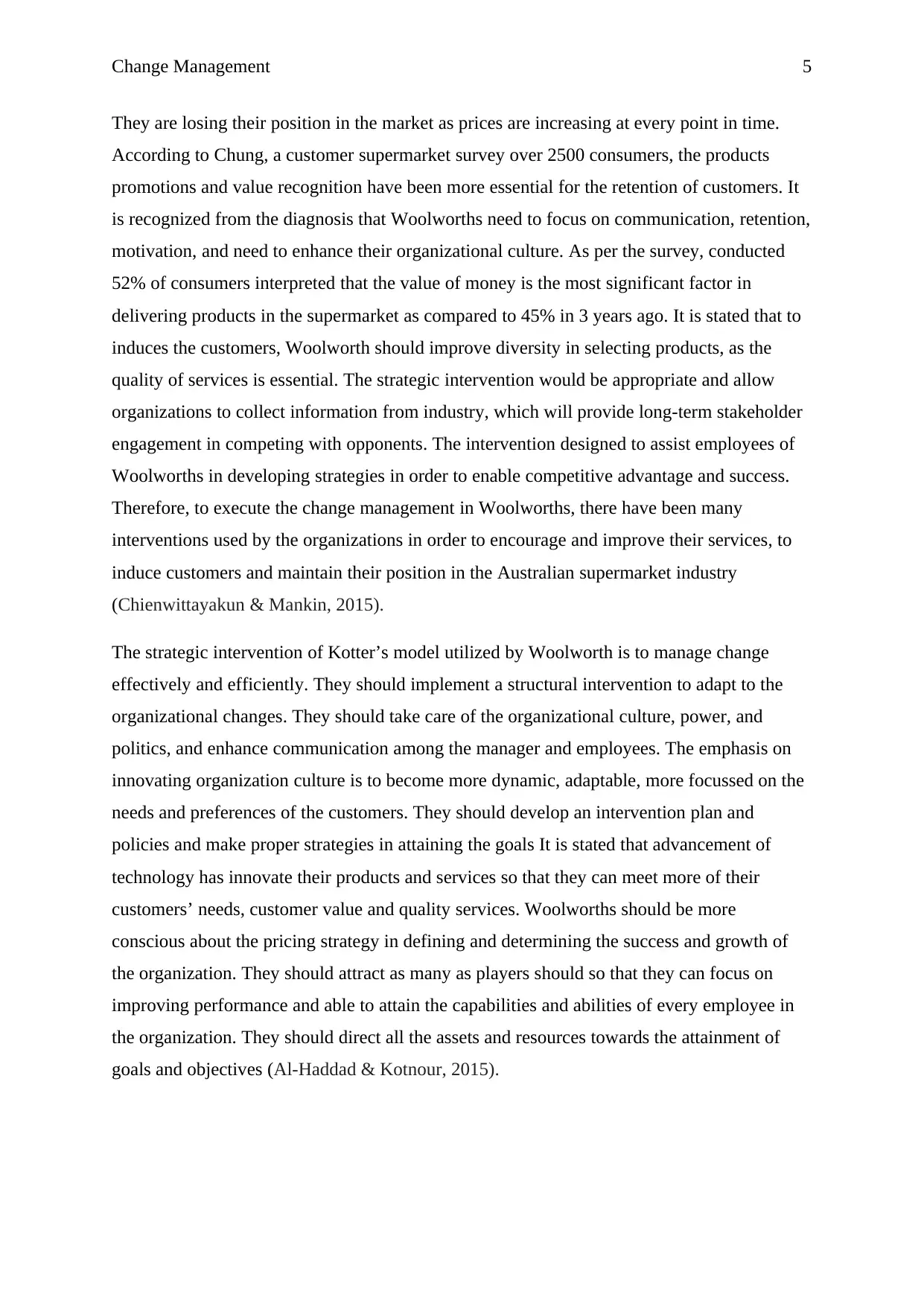
Change Management 5
They are losing their position in the market as prices are increasing at every point in time.
According to Chung, a customer supermarket survey over 2500 consumers, the products
promotions and value recognition have been more essential for the retention of customers. It
is recognized from the diagnosis that Woolworths need to focus on communication, retention,
motivation, and need to enhance their organizational culture. As per the survey, conducted
52% of consumers interpreted that the value of money is the most significant factor in
delivering products in the supermarket as compared to 45% in 3 years ago. It is stated that to
induces the customers, Woolworth should improve diversity in selecting products, as the
quality of services is essential. The strategic intervention would be appropriate and allow
organizations to collect information from industry, which will provide long-term stakeholder
engagement in competing with opponents. The intervention designed to assist employees of
Woolworths in developing strategies in order to enable competitive advantage and success.
Therefore, to execute the change management in Woolworths, there have been many
interventions used by the organizations in order to encourage and improve their services, to
induce customers and maintain their position in the Australian supermarket industry
(Chienwittayakun & Mankin, 2015).
The strategic intervention of Kotter’s model utilized by Woolworth is to manage change
effectively and efficiently. They should implement a structural intervention to adapt to the
organizational changes. They should take care of the organizational culture, power, and
politics, and enhance communication among the manager and employees. The emphasis on
innovating organization culture is to become more dynamic, adaptable, more focussed on the
needs and preferences of the customers. They should develop an intervention plan and
policies and make proper strategies in attaining the goals It is stated that advancement of
technology has innovate their products and services so that they can meet more of their
customers’ needs, customer value and quality services. Woolworths should be more
conscious about the pricing strategy in defining and determining the success and growth of
the organization. They should attract as many as players should so that they can focus on
improving performance and able to attain the capabilities and abilities of every employee in
the organization. They should direct all the assets and resources towards the attainment of
goals and objectives (Al-Haddad & Kotnour, 2015).
They are losing their position in the market as prices are increasing at every point in time.
According to Chung, a customer supermarket survey over 2500 consumers, the products
promotions and value recognition have been more essential for the retention of customers. It
is recognized from the diagnosis that Woolworths need to focus on communication, retention,
motivation, and need to enhance their organizational culture. As per the survey, conducted
52% of consumers interpreted that the value of money is the most significant factor in
delivering products in the supermarket as compared to 45% in 3 years ago. It is stated that to
induces the customers, Woolworth should improve diversity in selecting products, as the
quality of services is essential. The strategic intervention would be appropriate and allow
organizations to collect information from industry, which will provide long-term stakeholder
engagement in competing with opponents. The intervention designed to assist employees of
Woolworths in developing strategies in order to enable competitive advantage and success.
Therefore, to execute the change management in Woolworths, there have been many
interventions used by the organizations in order to encourage and improve their services, to
induce customers and maintain their position in the Australian supermarket industry
(Chienwittayakun & Mankin, 2015).
The strategic intervention of Kotter’s model utilized by Woolworth is to manage change
effectively and efficiently. They should implement a structural intervention to adapt to the
organizational changes. They should take care of the organizational culture, power, and
politics, and enhance communication among the manager and employees. The emphasis on
innovating organization culture is to become more dynamic, adaptable, more focussed on the
needs and preferences of the customers. They should develop an intervention plan and
policies and make proper strategies in attaining the goals It is stated that advancement of
technology has innovate their products and services so that they can meet more of their
customers’ needs, customer value and quality services. Woolworths should be more
conscious about the pricing strategy in defining and determining the success and growth of
the organization. They should attract as many as players should so that they can focus on
improving performance and able to attain the capabilities and abilities of every employee in
the organization. They should direct all the assets and resources towards the attainment of
goals and objectives (Al-Haddad & Kotnour, 2015).
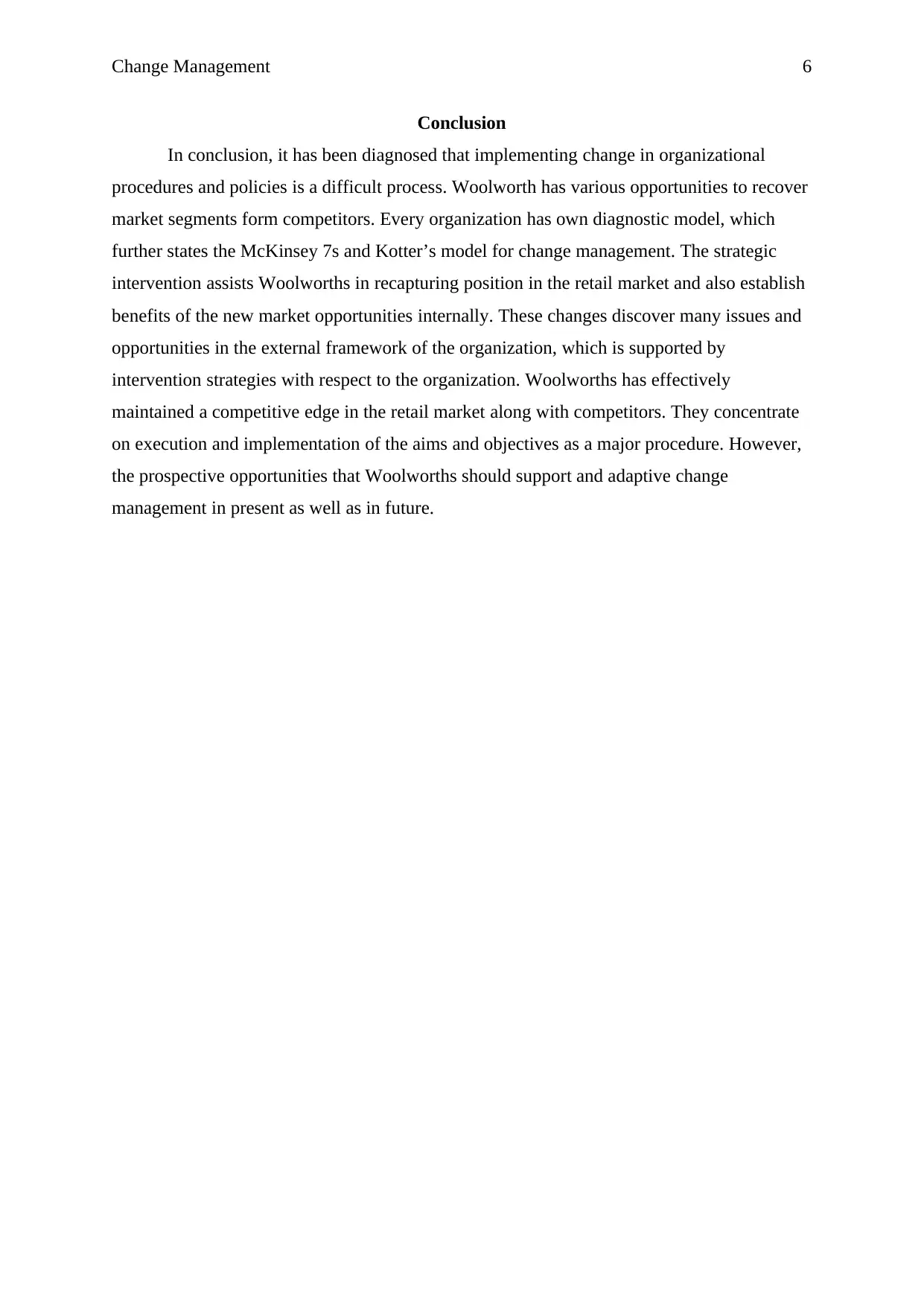
Change Management 6
Conclusion
In conclusion, it has been diagnosed that implementing change in organizational
procedures and policies is a difficult process. Woolworth has various opportunities to recover
market segments form competitors. Every organization has own diagnostic model, which
further states the McKinsey 7s and Kotter’s model for change management. The strategic
intervention assists Woolworths in recapturing position in the retail market and also establish
benefits of the new market opportunities internally. These changes discover many issues and
opportunities in the external framework of the organization, which is supported by
intervention strategies with respect to the organization. Woolworths has effectively
maintained a competitive edge in the retail market along with competitors. They concentrate
on execution and implementation of the aims and objectives as a major procedure. However,
the prospective opportunities that Woolworths should support and adaptive change
management in present as well as in future.
Conclusion
In conclusion, it has been diagnosed that implementing change in organizational
procedures and policies is a difficult process. Woolworth has various opportunities to recover
market segments form competitors. Every organization has own diagnostic model, which
further states the McKinsey 7s and Kotter’s model for change management. The strategic
intervention assists Woolworths in recapturing position in the retail market and also establish
benefits of the new market opportunities internally. These changes discover many issues and
opportunities in the external framework of the organization, which is supported by
intervention strategies with respect to the organization. Woolworths has effectively
maintained a competitive edge in the retail market along with competitors. They concentrate
on execution and implementation of the aims and objectives as a major procedure. However,
the prospective opportunities that Woolworths should support and adaptive change
management in present as well as in future.
Paraphrase This Document
Need a fresh take? Get an instant paraphrase of this document with our AI Paraphraser
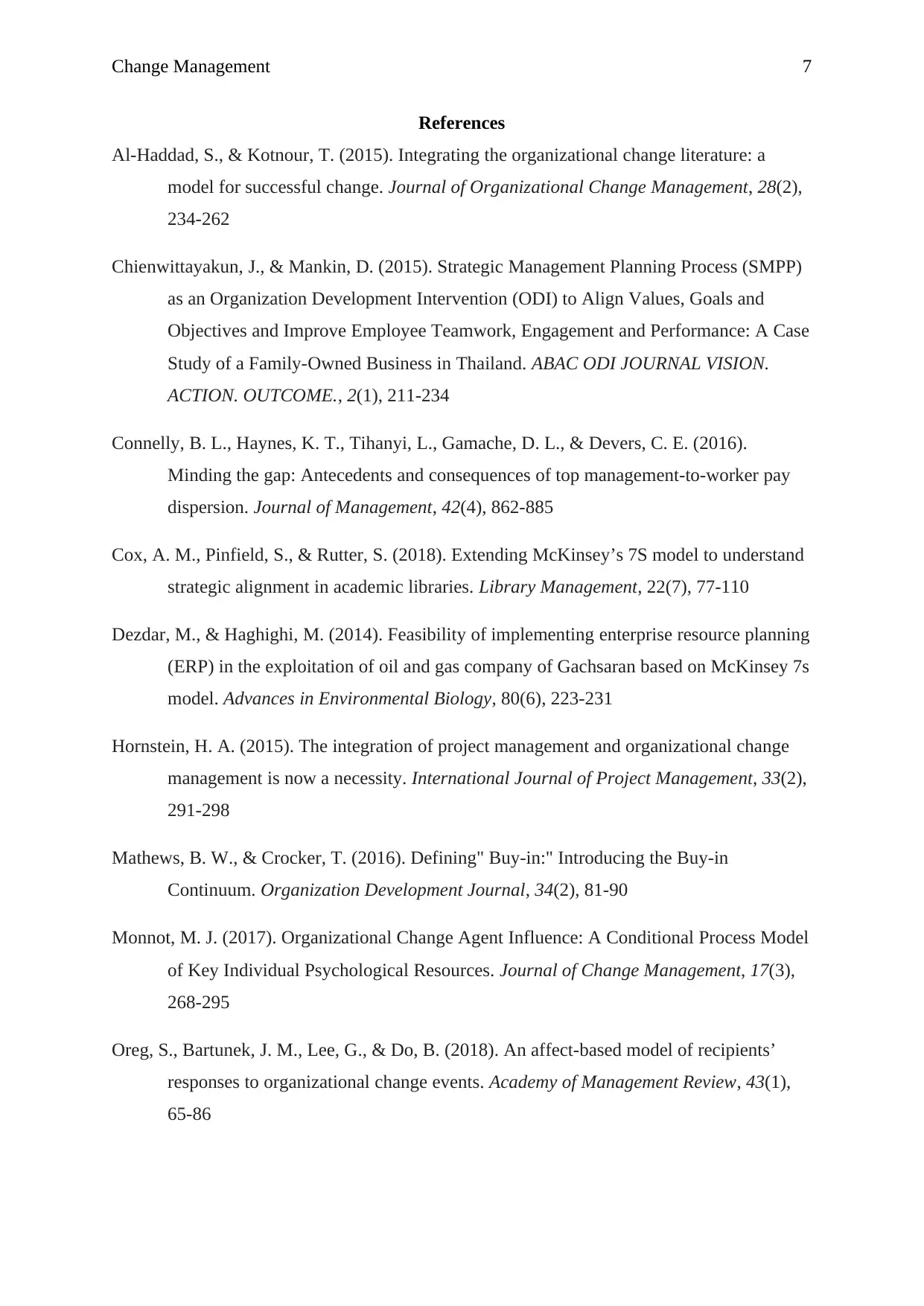
Change Management 7
References
Al-Haddad, S., & Kotnour, T. (2015). Integrating the organizational change literature: a
model for successful change. Journal of Organizational Change Management, 28(2),
234-262
Chienwittayakun, J., & Mankin, D. (2015). Strategic Management Planning Process (SMPP)
as an Organization Development Intervention (ODI) to Align Values, Goals and
Objectives and Improve Employee Teamwork, Engagement and Performance: A Case
Study of a Family-Owned Business in Thailand. ABAC ODI JOURNAL VISION.
ACTION. OUTCOME., 2(1), 211-234
Connelly, B. L., Haynes, K. T., Tihanyi, L., Gamache, D. L., & Devers, C. E. (2016).
Minding the gap: Antecedents and consequences of top management-to-worker pay
dispersion. Journal of Management, 42(4), 862-885
Cox, A. M., Pinfield, S., & Rutter, S. (2018). Extending McKinsey’s 7S model to understand
strategic alignment in academic libraries. Library Management, 22(7), 77-110
Dezdar, M., & Haghighi, M. (2014). Feasibility of implementing enterprise resource planning
(ERP) in the exploitation of oil and gas company of Gachsaran based on McKinsey 7s
model. Advances in Environmental Biology, 80(6), 223-231
Hornstein, H. A. (2015). The integration of project management and organizational change
management is now a necessity. International Journal of Project Management, 33(2),
291-298
Mathews, B. W., & Crocker, T. (2016). Defining" Buy-in:" Introducing the Buy-in
Continuum. Organization Development Journal, 34(2), 81-90
Monnot, M. J. (2017). Organizational Change Agent Influence: A Conditional Process Model
of Key Individual Psychological Resources. Journal of Change Management, 17(3),
268-295
Oreg, S., Bartunek, J. M., Lee, G., & Do, B. (2018). An affect-based model of recipients’
responses to organizational change events. Academy of Management Review, 43(1),
65-86
References
Al-Haddad, S., & Kotnour, T. (2015). Integrating the organizational change literature: a
model for successful change. Journal of Organizational Change Management, 28(2),
234-262
Chienwittayakun, J., & Mankin, D. (2015). Strategic Management Planning Process (SMPP)
as an Organization Development Intervention (ODI) to Align Values, Goals and
Objectives and Improve Employee Teamwork, Engagement and Performance: A Case
Study of a Family-Owned Business in Thailand. ABAC ODI JOURNAL VISION.
ACTION. OUTCOME., 2(1), 211-234
Connelly, B. L., Haynes, K. T., Tihanyi, L., Gamache, D. L., & Devers, C. E. (2016).
Minding the gap: Antecedents and consequences of top management-to-worker pay
dispersion. Journal of Management, 42(4), 862-885
Cox, A. M., Pinfield, S., & Rutter, S. (2018). Extending McKinsey’s 7S model to understand
strategic alignment in academic libraries. Library Management, 22(7), 77-110
Dezdar, M., & Haghighi, M. (2014). Feasibility of implementing enterprise resource planning
(ERP) in the exploitation of oil and gas company of Gachsaran based on McKinsey 7s
model. Advances in Environmental Biology, 80(6), 223-231
Hornstein, H. A. (2015). The integration of project management and organizational change
management is now a necessity. International Journal of Project Management, 33(2),
291-298
Mathews, B. W., & Crocker, T. (2016). Defining" Buy-in:" Introducing the Buy-in
Continuum. Organization Development Journal, 34(2), 81-90
Monnot, M. J. (2017). Organizational Change Agent Influence: A Conditional Process Model
of Key Individual Psychological Resources. Journal of Change Management, 17(3),
268-295
Oreg, S., Bartunek, J. M., Lee, G., & Do, B. (2018). An affect-based model of recipients’
responses to organizational change events. Academy of Management Review, 43(1),
65-86
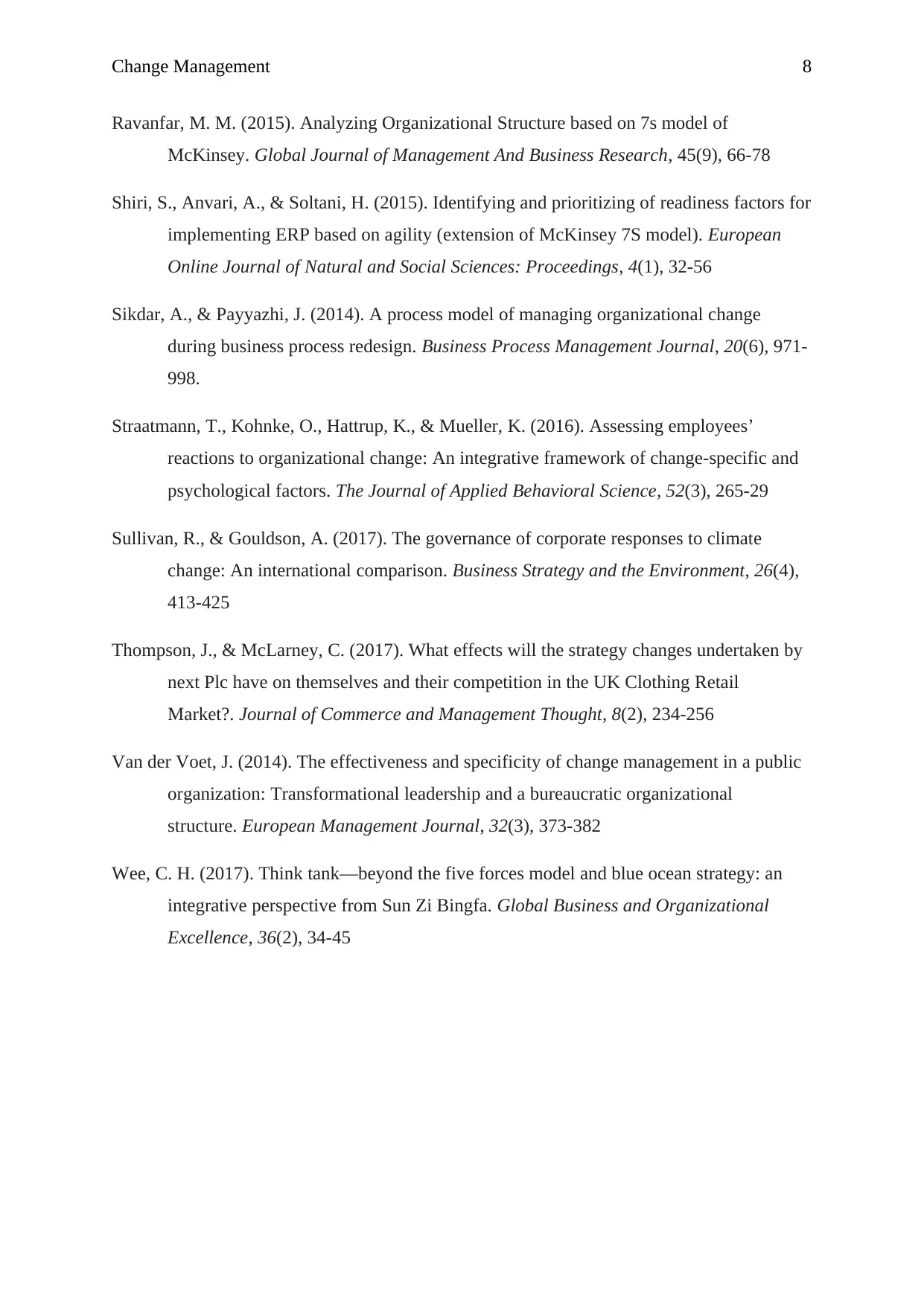
Change Management 8
Ravanfar, M. M. (2015). Analyzing Organizational Structure based on 7s model of
McKinsey. Global Journal of Management And Business Research, 45(9), 66-78
Shiri, S., Anvari, A., & Soltani, H. (2015). Identifying and prioritizing of readiness factors for
implementing ERP based on agility (extension of McKinsey 7S model). European
Online Journal of Natural and Social Sciences: Proceedings, 4(1), 32-56
Sikdar, A., & Payyazhi, J. (2014). A process model of managing organizational change
during business process redesign. Business Process Management Journal, 20(6), 971-
998.
Straatmann, T., Kohnke, O., Hattrup, K., & Mueller, K. (2016). Assessing employees’
reactions to organizational change: An integrative framework of change-specific and
psychological factors. The Journal of Applied Behavioral Science, 52(3), 265-29
Sullivan, R., & Gouldson, A. (2017). The governance of corporate responses to climate
change: An international comparison. Business Strategy and the Environment, 26(4),
413-425
Thompson, J., & McLarney, C. (2017). What effects will the strategy changes undertaken by
next Plc have on themselves and their competition in the UK Clothing Retail
Market?. Journal of Commerce and Management Thought, 8(2), 234-256
Van der Voet, J. (2014). The effectiveness and specificity of change management in a public
organization: Transformational leadership and a bureaucratic organizational
structure. European Management Journal, 32(3), 373-382
Wee, C. H. (2017). Think tank—beyond the five forces model and blue ocean strategy: an
integrative perspective from Sun Zi Bingfa. Global Business and Organizational
Excellence, 36(2), 34-45
Ravanfar, M. M. (2015). Analyzing Organizational Structure based on 7s model of
McKinsey. Global Journal of Management And Business Research, 45(9), 66-78
Shiri, S., Anvari, A., & Soltani, H. (2015). Identifying and prioritizing of readiness factors for
implementing ERP based on agility (extension of McKinsey 7S model). European
Online Journal of Natural and Social Sciences: Proceedings, 4(1), 32-56
Sikdar, A., & Payyazhi, J. (2014). A process model of managing organizational change
during business process redesign. Business Process Management Journal, 20(6), 971-
998.
Straatmann, T., Kohnke, O., Hattrup, K., & Mueller, K. (2016). Assessing employees’
reactions to organizational change: An integrative framework of change-specific and
psychological factors. The Journal of Applied Behavioral Science, 52(3), 265-29
Sullivan, R., & Gouldson, A. (2017). The governance of corporate responses to climate
change: An international comparison. Business Strategy and the Environment, 26(4),
413-425
Thompson, J., & McLarney, C. (2017). What effects will the strategy changes undertaken by
next Plc have on themselves and their competition in the UK Clothing Retail
Market?. Journal of Commerce and Management Thought, 8(2), 234-256
Van der Voet, J. (2014). The effectiveness and specificity of change management in a public
organization: Transformational leadership and a bureaucratic organizational
structure. European Management Journal, 32(3), 373-382
Wee, C. H. (2017). Think tank—beyond the five forces model and blue ocean strategy: an
integrative perspective from Sun Zi Bingfa. Global Business and Organizational
Excellence, 36(2), 34-45
1 out of 9
Related Documents
Your All-in-One AI-Powered Toolkit for Academic Success.
+13062052269
info@desklib.com
Available 24*7 on WhatsApp / Email
![[object Object]](/_next/static/media/star-bottom.7253800d.svg)
Unlock your academic potential
© 2024 | Zucol Services PVT LTD | All rights reserved.



